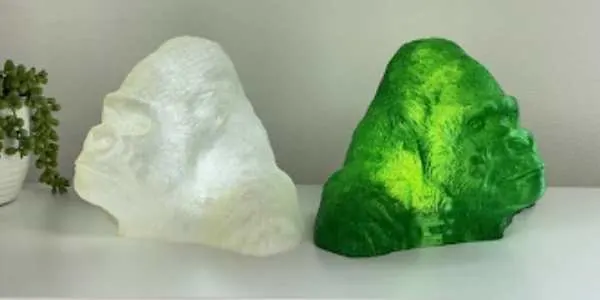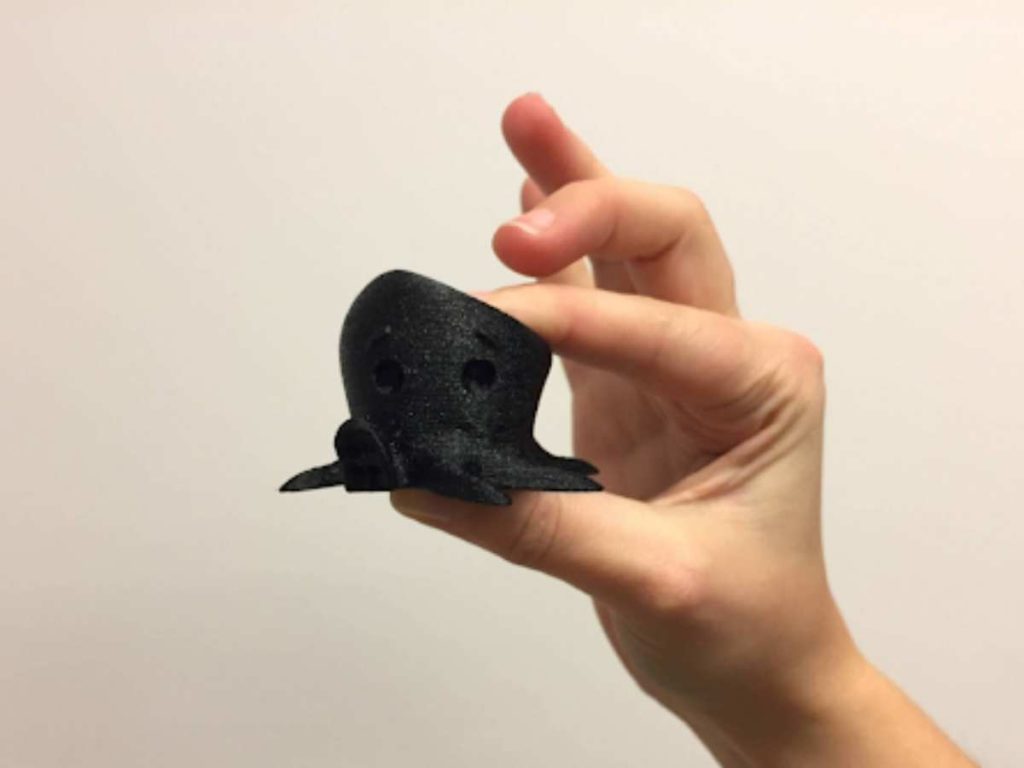With each innovation in 3D printing materials, new possibilities (and challenges) present themselves. TPU is one such innovation. Unlike many standard materials, which are stiff, rigid plastics, TPU is flexible. This flexibility adds a new dimension to printing possibilities. It does have its unique challenges; however, with enough practice (and maybe some small printable upgrades), it can be printed with relative ease.
TPU, or Thermoplastic Polyurethane, is a semi-flexible 3D printing filament similar to rubber. TPU has the desirable characteristics of being chemically resistant and incredibly durable, making it an excellent material for projects that are impossible with standard filaments.
What is TPU Good For?
TPU, while not always the right choice for every project, can be an invaluable tool if used correctly. This article will discuss applications, properties, different brands, and a few printing tips to help both newcomers and printing veterans.
The benefits of TPU are twofold. It has a unique and desirable aesthetic appeal and incredibly unique physical properties. TPU filaments are primarily available in matte and clear. The matte finish you can get with smaller layer thicknesses is almost unmatched. This is due to its ability to absorb light in a way that is impossible for PLA or other standard filaments, as shown below.

TPU in transparent colors is some of the clearest colored filament you can use with relative ease. From a utility standpoint, this helps create anything that needs to diffuse or color light.

The mechanical and chemical properties that make TPU so interesting are its elasticity, flexibility, durability, and chemical stability. In a recent article, we briefly discussed the application of TPU for phone cases due to its flexibility and UV resistance. Beyond phone cases, it is also convenient for adapters or accessories. With rigid filaments, you end up having to either make it too loose, too tight or struggle with some creative solution to affix it to a pre-existing item. With TPU, you can simply stretch the print slightly to fit over or in wherever it needs to go. And due to this flexibility, it also creates a near watertight seal if done correctly. I have also found success in creating uniquely shaped grommets and O-Rings to create a water- or air-tight seal between multiple parts.
It is a big concern in the 3D printing community that filaments can be toxic during printing or in use. Luckily, TPU is BPA-free and produces no harmful fumes during printing. This means no need for a fume hood, and it can be used for printing things like water bottles, lids, or any other food storage. This does vary slightly from brand to brand, so always double-check before printing in a small unventilated room or using prints for food or water.
How Strong is TPU?
Determining the specific strength of any printing filament is tricky because it depends on both the print setting used and the brand of filament. However, Most brands are similar enough to come to a fair consensus. All specs below are for a solid piece of TPU. The exact strength of printed parts will vary slightly depending on the print settings used.
TPU Material Specs:
Elongation: ~450%
Tensile Strength: 150 MPa (Megapascals)
Shore Hardness 98A
If the specs mentioned earlier mean nothing to you, here is a breakdown of the properties using a more tangible metric. For comparison, let’s use a standard ¼ inch thick rubber band. If you’ve ever held a rubber band that has a light coating of powder on it, those are the ones that are made of real rubber.
The elongation percentage describes the distance a material can be stretched before snapping. A rubberband has an elongation percentage of about 700%
The tensile strength measures the amount of force needed to stretch a material until it breaks. A rubber band has a tensile strength of 10-25 MPa. 1 MPa is about 1kg of force (this isn’t entirely correct, but it is an apt conversion).
Shore Hardness is a fairly complex metric. However, we will simplify it by saying it is the measure of how hard it is to poke a hole into or deform a material successfully. Our rubber band has a shore hardness of 25A-36A. Unfortunately, there is no way to convert shore hardness to kg of force in this scenario. Instead, you’ll just have to see it as TPU being about 3.5 times more resistant to being stabbed.
Is TPU filament grippy?
Due to the nature of any flexible material, it is going to be grippier than most rigid materials. The answer to “how grippy is TPU?” It depends on the part’s geometry, the direction of the force applied, and what it’s rubbing up against.
Think about the grip on your trainers. While shoe rubber is by nature incredibly grippy, once the pattern of the grip wears down, you see a considerable drop off in the amount of grip. However, even if your shoes are brand new, if the grip is made of rigid plastic, the amount of grip will make little to no difference on a smooth surface. To maximize the amount of grip on your printed part, it is recommended that you add a texture to the surface. However, even a flat TPU surface will provide more grip than a textured PLA surface.
Another factor to consider is the direction of the force. If maximizing grip is your goal, then layer lines might actually work to your benefit for once. You want to make sure the direction of force is perpendicular to the layer lines, as they will act as a sort of grip texture that will create friction and grip between surfaces.
As a basic comparison, TPU will be grippier than something like silicone but not quite as grippy as rubber.
Is TPU filament flexible?
Once again, the answer is yes and no. The flexibility of a print depends on the settings you use and the geometry and size of the printed part.
The two biggest challenges with TPU are layer adhesion and under-extrusion. If either of those issues is present in your print, then it will greatly decrease the strength of the print, which would make it less flexible than it could be. You also have to keep in mind the density of the print. A thick block of TPU is going to stretch and bend less than a thin string of it. It feels like a bouncy rubber ball when printed as a solid chunk.
Key settings for a more flexible print:
- Infill percentage: As low as possible (in my experience, 5% is the practical minimal infill for you unless you use vase mode)
- Infill pattern: Gyroid or ZigZag (Do not “connect infill lines”)
- Infill layer thickness: Double the regular layer thickness
Key settings for a less flexible print:
- Infill Percentage: 80% (anything higher will make it solid but will start to compromise the strength)
- Infill pattern: Grid with connected infill lines
- Infill layer thickness: As small as possible
5 Best TPU filaments
The brand of TPU you choose will depend on why you are using TPU. This list is in no particular order and goes through the best use case for each pick, along with an honorable mention at the end.
1. Overture Brand TPU. Overture is an excellent choice of filament if your primary concern is the aesthetics of the print. They have a wide range of vibrant colors, both matte and transparent.
Pros: Lots of colors, and it’s no more expensive than standard PLA
Cons: A bit weaker than other brands, a higher temperature needed to avoid layer adhesion issues, not great at printing overhangs.
2. Hatchbox brand TPU. Hatchbox is going to be a good middle ground between aesthetics and strength.
Pros: One of the stronger and more affordable brands of TPU, Color options have a beautiful matte finish
Cons: Slightly more expensive ($30-35) per KG, Minimal options for color, and at the time of writing this, they have no transparent TPU options.
3. YOYI YOYI Brand TPU. This is the most flexible TPU brand I have used, so if you want a super squishy print, this is a great option
Pros: Incredibly flexible, cheaper than PLA (~$20 per KG)
Cons: Colors are quite basic; it clogs the extruder more than any other brand (that could just be a me problem, so take this with a grain of salt)
4. SainsSmart Brand TPU. SainsSmart is my standard go-to brand for TPU because my main reason for using TPU is flexibility and transparency.
Pros: One of the best looking and most consistent transparent colors, Prints easily, handles overhangs well, and has a wide range of transparent colors
Cons: limited non-transparent colors, 2nd most expensive brand on this list (~$30 per 0.8kg)
5. GIANTARM Brand TPU. This brand gets a spot on this list for its clear TPU. If you want the most transparent possible print, I would give this a try.
Pros: Super clear prints and very smooth surfaces
Cons: Other colors are pretty average, and it reportedly does not handle overhangs very well.
Honorable mention: NinjaTek Brand TPU. NinjaTek is one brand that I had to include. Because it’s the strongest, grippiest, most flexible, and has the best surface quality of any other brand on this list. The reason it’s not part of the main five is due to its hefty price of $60-$70 for 1KG. I’m currently working on a custom design for 3D printed trainers, and I’m printing most of the shoe in this material.
Tips for printing TPU
After reading this, if you are planning on picking up some TPU for the first time or you’ve been using TPU and are having issues. I’ve struggled many hours and have had to trash countless prints. Maybe you can avoid the same mistakes I made 🙂
- First and most importantly, if you have an older printer, you will 100% need to get a direct drive extruder or, at the very least an upgraded one.
- The biggest issue with flexible filaments like TPU is that they like to clog the extruder because it WILL slip out of any open crack. This printable extruder upgrade closes the gap between the extruder gears and the entrance to the PTFE tube.
- Supports are HARD. Using supports with TPU prints is possible but not to the same degree as PLA; when possible, avoid them outright.
- You don’t necessarily NEED an all-metal hot-end, but it does help quite a bit because you want to print TPU fairly hot (230-250 Celsius) to avoid layer adhesion issues.
- Speed is your enemy with TPU. You want to print it slowly, or you risk clogging, under extrusion, layer adhesion issues, and holes in your top surfaces.
Conclusion
TPU is a versatile and incredibly interesting material. It does have a bit of a learning curve and probably will require a few upgrades to print it consistently. But, once you have a brand you like, it’s incredibly fun to work with. The satisfaction of printing something and crushing it in your hand, and having it spring right back is borderline cathartic. And being able to print adapters, phone cases, grips, etc., that feels soft in your hand and most of the time work even better than the mass-produced product is something that’s been impossible with hard plastics like PLA or ABS. I feel that TPU and materials like it have a lot of potential in the 3D printing space.
- Written by:
- Ben
- Last updated:
- 11/22/2023
About Ben
I started 3D printing since 2013 and have learned a lot since then. Because of this I want to share my knowledge of what I have learned in the past years with the community. Currently I own 2 Bambulab X1 Carbon, Prusa SL1S and a Prusa MK3S+. Hope you learn something from my blog after my years of experience in 3D printing.







